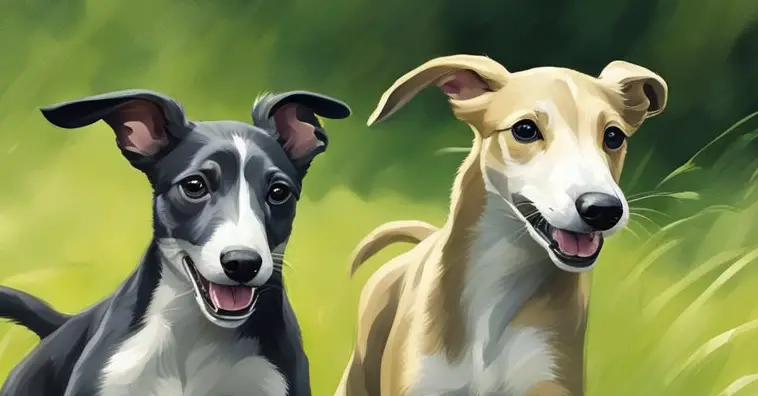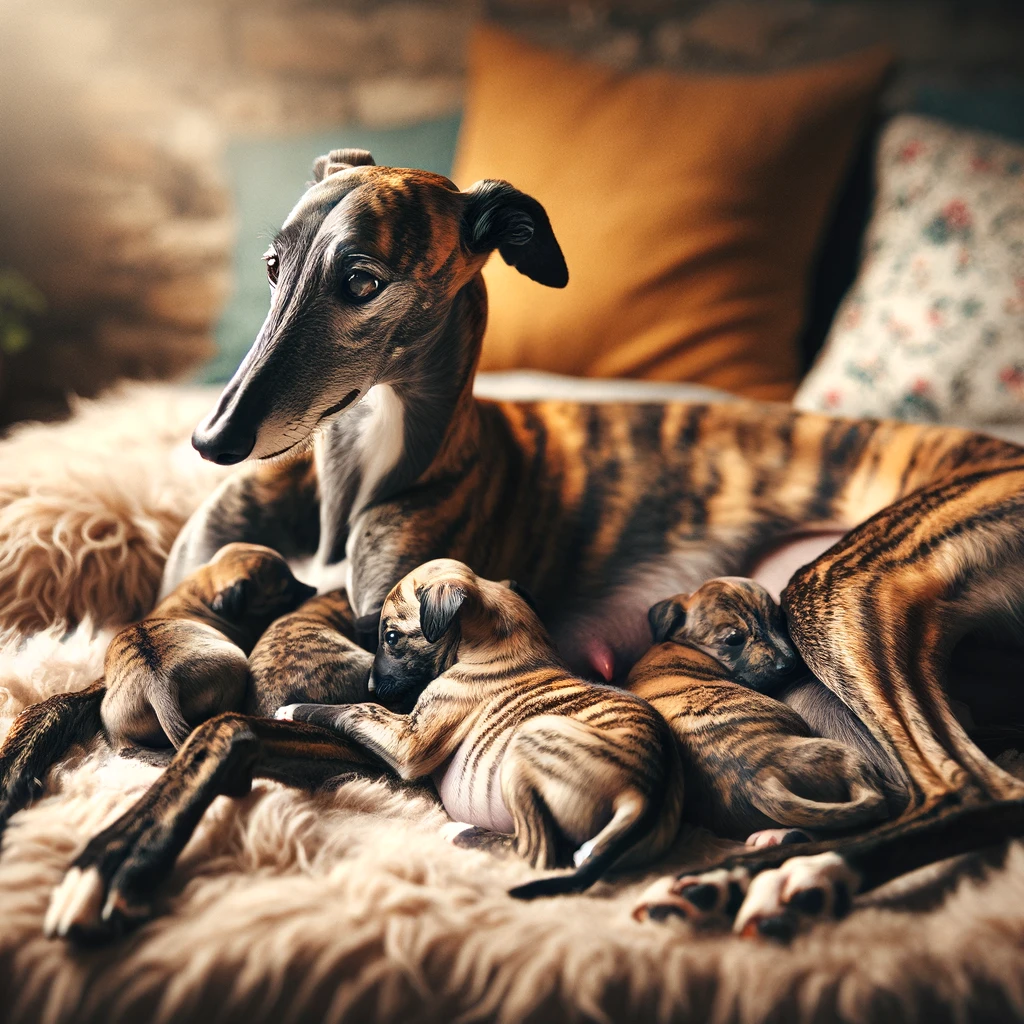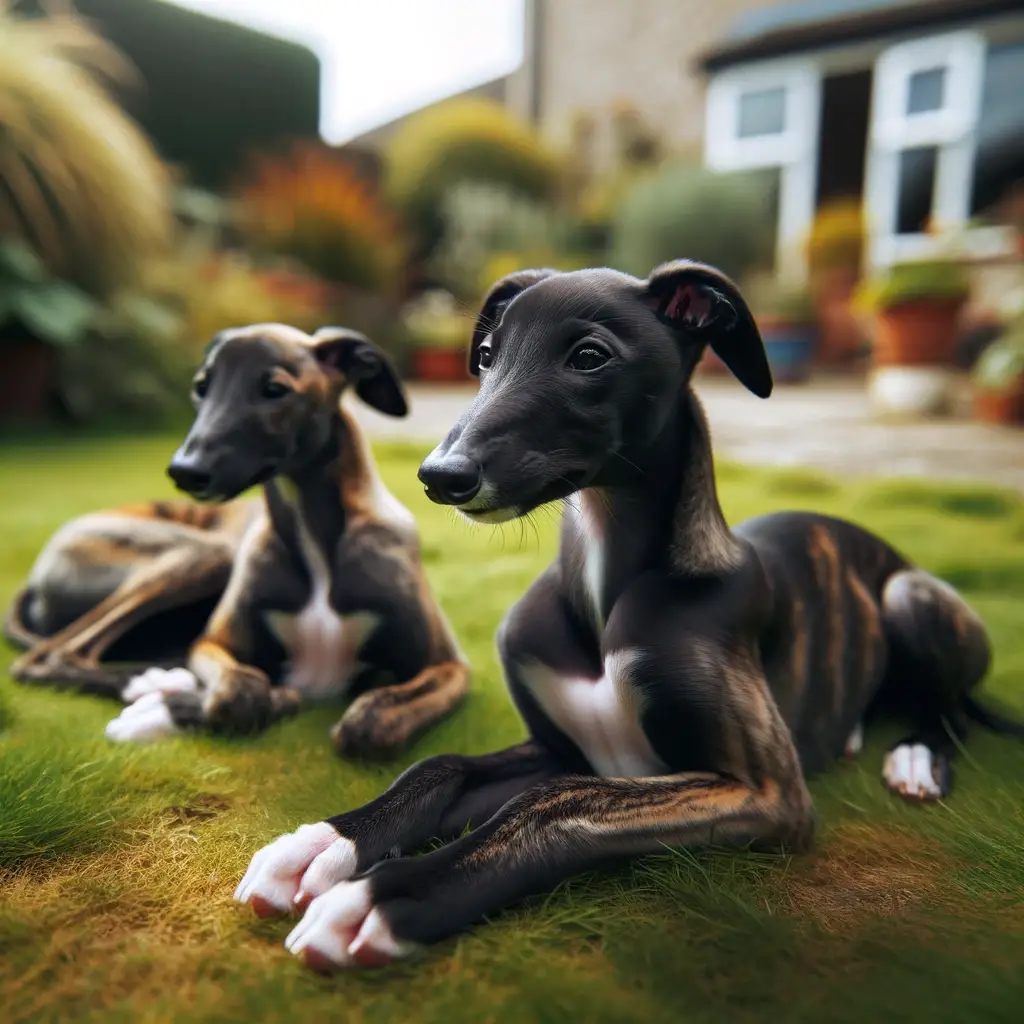Welcome to the world of Greyhound puppies, a realm where grace meets playfulness and speed meets snuggles!
This essential guide is designed to help new owners navigate the joys and responsibilities of caring for these elegant canine companions. From their sleek, aerodynamic build to their heartwarming loyalty, Greyhound puppies are a unique blend of athleticism and affection that can enrich any home.
As a new Greyhound puppy owner, you’re embarking on an exciting journey. These intelligent and gentle pups will not only become your fast friends—quite literally—but also your devoted couch companions.
In this guide, we’ll cover everything you need to know about raising a healthy and happy Greyhound, from the best ways to meet their exercise needs to understanding their distinctive nutritional requirements.
Adopting a Greyhound puppy is both a delight and a commitment. We’ll delve into the specifics of their grooming and hygiene, how to spot and address common health issues, and the importance of early socialization and training.
Whether you’re bringing home a bouncing Greyhound pup or considering adoption, this guide will arm you with the knowledge to provide the best care possible.
So, let’s get started on this thrilling adventure with your new four-legged friend. Greyhound puppies are not just swift runners, they’re also swift at stealing hearts. By the end of this guide, you’ll be fully equipped to make your puppy’s transition into your family as smooth and joyful as their iconic stride.
Table of Contents
Breed Characteristics
Let’s look at the distinctive physical traits, temperament, and exercise demands that are characteristic of Greyhound puppies. Understanding these attributes can help you provide the best care for your new pet.
Physical Attributes
Greyhound puppies are the epitome of grace and potential, with a slender, aerodynamic build that hints at their future speed. Even at a young age, they possess long, lean legs and a deep chest that will later enable them to excel in breathtaking sprints.
Their coats are short and smooth, often found in a variety of colors such as black, white, brindle, fawn, blue, and red. With their bright, intelligent eyes and perky ears that may either stand up or fold at the tips, these puppies exude curiosity and alertness.
Their tapered tails wag with youthful enthusiasm, and their overall demeanor is one of gentle friendliness and an eagerness to bond with their human companions.
Temperament
Greyhound puppies are a delightful blend of gentle affection and playful spirit. Known for their sweet and docile nature, these charming pups often exhibit a calm temperament that belies their racing lineage.
They are typically friendly, both with their human families and with other dogs, showing a sociable streak from an early age.
Greyhound puppies are also known for their intelligence and quick learning abilities, making them responsive to training with the right guidance and positive reinforcement.
Despite their potential for high-energy bursts, they are surprisingly laid-back and are often content to lounge around after a good play session.
Their sensitivity and keen sense of connection with their owners make them wonderful companions who are attuned to the moods and emotions of those around them.
Exercise Needs
Greyhound puppies, with their sprightly legs and boundless energy, require regular exercise to stay healthy and happy. These little bundles of joy love to stretch their developing muscles with short bursts of running and playful frolicking.
While they may seem like they could sprint forever, it’s important to remember that their exercise needs should be met with care to avoid overexertion while their bones and joints are still growing.
Daily walks, interactive play sessions, and safe opportunities to explore in a securely fenced area provide the perfect outlets for their vigor. As much as they love physical activities, Greyhound puppies also appreciate downtime and are quite content to curl up for a cozy nap after a good dose of exercise.
Keeping a balance between activity and rest is key to raising a well-rounded and healthy Greyhound pup.
Caring for a Greyhound Puppy
When you welcome a Greyhound puppy into your home, you’re embarking on a journey that requires dedication and knowledge. Your new companion will thrive with proper nutrition, consistent grooming, and effective training. Let’s break down these critical aspects of care to ensure your Greyhound puppy grows into a healthy, well-adjusted dog.
Nutrition Requirements
Greyhound puppies have specific nutritional requirements to support their rapid growth and development. They need a diet that’s rich in high-quality proteins to build strong muscles, and adequate fats for energy and a healthy coat.
It’s important to feed them a balanced puppy formula that also includes the right amounts of calcium and phosphorus to promote strong bone development. Puppies enjoy kibble but you need to ensure the kibble is specifically for puppies.
Since puppies grow quickly, they’ll benefit from several small meals throughout the day rather than one or two large ones, which can help prevent bloating.
Always ensure they have access to fresh water, and consider consulting with a vet to tailor a feeding plan that’s just right for your Greyhound’s individual needs. Proper nutrition in these early months lays the foundation for a healthy and happy life.
Grooming and Hygiene
Greyhound puppies are quite low-maintenance when it comes to grooming and hygiene, which is great news for pet parents!
Their short, smooth coats don’t shed excessively and only require a quick once-over with a rubber brush or grooming mitt a few times a week to remove loose fur and keep their coat shiny.
Bathing your Greyhound puppy doesn’t need to be a frequent task as doing so every few months or when they get particularly dirty is usually sufficient. When you do bathe them, make sure to use a gentle dog shampoo to protect their skin.
Regular nail trims, ear cleaning, and dental care are also important to keep your Greyhound puppy in tip-top shape.
Keeping up with these simple grooming routines will not only help your puppy look their best but also provide an opportunity to bond and check for any skin issues or parasites.
Training and Socialization
Early training is crucial to tap into the Greyhound’s natural inclination for obedience. Begin with simple commands and positive reinforcement techniques.
Socialization is equally important as that will expose your Greyhound to different environments, people, and other dogs, which helps them become well-adjusted adults.
Greyhounds are generally good with other dogs and make excellent companions with the right training and social interaction.
Remember to approach your Greyhound puppy with a routine that balances exercise, affection, and discipline. This will foster a mutual respect and strong bond between you and your puppy, paving the way for a fulfilling coexistence.
Health and Genetics
When considering a Greyhound puppy, your awareness of potential health issues and the importance of genetic screening is crucial for the well-being of your new pet.
Common Health Issues
Like all breeds, Greyhound puppies can be predisposed to certain health issues, but being informed can help you keep your pup thriving.
Greyhounds are generally healthy, but it’s good to be aware of conditions such as osteosarcoma (bone cancer), which they can be prone to later in life.
They may also experience bloat, a rapid, life-threatening stomach condition, so it’s important to monitor their eating habits and provide meals in moderation.
Greyhounds have thin skin, which means even a playful romp can sometimes lead to scrapes or cuts, so keep a pet-friendly first aid kit handy.
Lastly, their lean bodies and low body fat can make them sensitive to extreme temperatures, so providing a warm bed and proper shelter is essential.
Regular check-ups with your vet will help catch any health concerns early, ensuring your Greyhound puppy grows up to be a strong and graceful companion.
Genetic Related Issues
Greyhound puppies, with their distinctive build and swift gaits, can inherit a few genetic predispositions that prospective owners should be mindful of.
One such condition is Greyhound Neuropathy, a rare inherited neuromuscular disorder that can manifest early in a puppy’s life.
Additionally, they can be genetically predisposed to heart conditions like cardiomyopathy, which requires vigilant monitoring for any signs of heart distress.
Their sleek physique also means they can be more susceptible to anesthesia sensitivity, so it’s crucial to discuss this with your vet before any surgical procedures.
Being proactive with genetic testing and seeking out reputable breeders who prioritize health and genetic screening can help mitigate these risks. Knowledge and preventive care are key to ensuring your Greyhound puppy leads a robust, full life.
Finding a Greyhound Puppy
When you’re looking to bring a Greyhound puppy into your home, it’s crucial to find a reputable breeder or consider adoption. You’ll need to evaluate breeders carefully and navigate the adoption process with awareness.
Choosing a Breeder
Your first step in finding a Greyhound puppy for sale is to identify a reliable breeder who prioritizes health and temperament.
Look for American Kennel Club (AKC) registration, which often signifies that the breeder follows ethical breeding standards and maintains a documented pedigree.
Registered kennels are transparent about their breeding practices and health screening processes. You should expect to:
- Visit the breeding facility to observe the conditions.
- Meet the puppy’s parents to gauge future characteristics.
- Review health clearances and vaccinations.
Finding a responsible breeder builds the foundation for a healthy and well-socialized puppy. For instance, PuppySpot insists on only listing puppies from professional breeders committed to dog well-being.
Here are some AKC breeders and resources where you can find Greyhound puppies in the United States:
- AKC Marketplace: This is the official site to find AKC-Registered Greyhound pups.
- WINDROCK LLC: A top breeder of AKC Dual Champion Greyhounds known for their athletic prowess and conformation.
- North Shore Kennel: Offers dual registered NGA/AKC Greyhounds and conducts health testing through Embark and Paw Print Genetics.
- ARK Kennel: A breeder of AKC and NGA-Certified American Racing Greyhounds based in Mesa, AZ.
For a comprehensive list, it’s best to visit these websites and reach out directly for the most current information on available puppies and upcoming litters. Always ensure that any breeder you consider follows ethical breeding practices and prioritizes the health and well-being of their dogs.
The Adoption Process
If you’re leaning towards adoption, numerous rescue organizations specialize in rehoming Greyhounds. The adoption process often includes:
- Filling out a detailed application process to ensure a good fit.
- A home visit may be required to ensure your living condition is suitable for a Greyhound.
- An adoption fee that typically covers the cost of spaying/neutering, vaccinations, and vet care.
Adopting a Greyhound can be a rewarding alternative to buying from a breeder. Resources like Adopt-a-Pet can help connect you with Greyhounds in need of a home. Remember, adopting a dog requires a commitment to care for their needs throughout their life.
Greyhound puppies are normally a bit tougher to find. Most Greyhound rescues only have slightly older dogs, mainly because Greyhounds normally race between ages 2 and 5 years. To find a Greyhound puppy, look for breeders who specialize in and have a good reputation with Greyhounds.
That’s all for today. I hope you enjoyed this post about Greyhound puppies. They’re certainly cute and are great for families. Although we always recommend adopting an older Greyhound to provide them a better life after their racing careers, puppies are always nice for families as well. Take care and see you back here soon.








